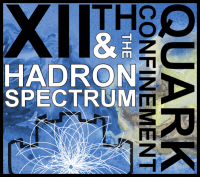Speaker
Description
Since the discovery of the $X(3872)$ in 2003 [1] it became evident that the naive
quark model would not be enough to describe all the baryon spectrum. This state
has properties that can not be explained in such a quark model, as its decay into
$J/\Psi \pi \pi$ through a $\rho$ meson, which is an isospin violating decay. However
this property can be easily explained in a picture in which the state in understood
as a $DD^*$ bound state, due to the isospin violation in the $D$ and $D^*$ masses and the
close position of the state to the $D_0D^*_0$ threshold. In previous studies [2] we described
the X(3872) as a $DD^*$ molecule coupled to the $2P$ $c\bar c$ state, which in our
framework is essential to bind the system. The coupling of two and four quark states
was performed microscopically using the $^3P_0$ model [3]. Although it was shown that the
contribution to the mass of the coupling to the $1P$ and $3P$ states is small, some decay
properties could have a sizable contribution, like the radiative decays. Including
many different states makes the problem too involved and so the contribution of
all the tower of bound quark-antiquark states remains as an open question.
For this reason we have developed a new framework in which the contribution of all the
states can be obtained. To do so, the main idea is not to expand the quark-antiquark
wave function in a linear combination of bare quark-antiquark states, but leave the radial wave
function as an unknown of the problem solving for it. We have applied it to the study
of the $X(3872)$ and check that when the $^3P_0$ coupling is small the results are the same
as the perturbative calculation and for the physical value of the coupling some
deviations are obtained. We have studied the probability of bare states in the
physical one and the most important is the $2P$ as expected. Different decay properties
will be presented.
[1] S.K. Choi et al. (Belle Collaboration), Phys. Rev. Lett. 91, 262001 (2003).
[2] P.G. Ortega, J. Segovia, D.R. Entem and F. Fernandez, Phys. Rev. D 81, 054023 (2010).
[3] J. Segovia, D.R. Entem and F. Fernandez, Phys. Lett. B 715, 322 (2012).
Summary
In recent years states in the quarkonium spectrum not expected in the
naive quark model have appeared and created a lot of interest. In the
theoretical side the study of the effect of meson-meson thresholds in
the spectrum have been performed in different approximations. In a quark
model framework, and in the spirit of the Cornell model, when a meson-meson
threshold is included, the coupling to all the quark-antiquark states
have to be considered. In practice only the closest states are included
perturbatively. In this contribution we will present a framework in which
we couple quark-antiquark states with meson-meson states non-perturbatively,
taking into account effectively the coupling to all quark-antiquark states.
The method will be applied to the study of the $X(3872)$ and a comparison with the
perturbative calculation will be performed.




